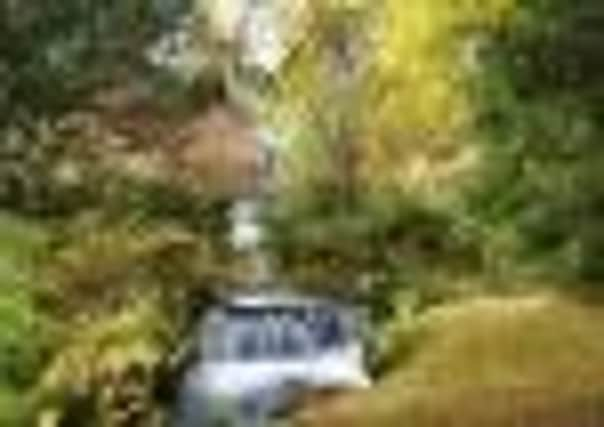Gardens: Stobo estate


The garden lies across a small valley, landscaped 100 years ago, and belongs to Stobo estate, which has been in the Seymour family for more than 40 years. Adjacent Stobo Castle was sold by the family and is now a well-known health spa, “but the Seymours hung on to the surrounding policies”, says Hugh Seymour.
He and his wife Georgina run a farm on the estate. With the help of a part-time gardener, they also spend a lot of their time working on the Japanese water garden. Throughout this winter, they will clear tonnes of leaves shed by trees which were very unusual at the time they were introduced. This autumn has provided a spectacular show right into November in this corner of Peeblesshire. The area is one of the best for autumn leaf colour, but at Stobo this is not at the expense of the other seasons.
Advertisement
Hide AdAdvertisement
Hide AdNo sooner has its autumn carpet lost its gold, work begins to clear it away. The spring flowers at Stobo create as big an impact as the autumn leaves.Georgina says: “The primroses were prolific this year, along with the wood anemones and dogtooth violets. Ten years ago there was the odd clump of primroses but now they cover the bank and are a feature in own right – they flowered for about three months. But they wouldn’t be as good if the leaves were not moved. The work in autumn prepares the way for this.”


Although the trees are the focus for autumn, Stobo is a water garden, and lavishly so. It was laid out 100 years ago by Hylton Philipson, a test cricketer with a love of Japanese design and gardens. The source of the central burn is in the hills above Stobo. Using labour garnered from the region’s growing reservoir works, Philipson had a dam built high in the hills, creating a loch to make hydro power for the estate. A pleasure loch was then dug out at the castle’s boundary and the vogue for “japonaiserie” celebrated in the white bridge that crosses the dam. The view across to the hills is contrasted on the other side of the bridge; the land falls away dramatically with the first of the man-made waterfalls, dropping to a pool about 30ft below.
The waterfall itself, Hugh attests, is a “power shower with a difference” for those brave enough. A pattern of waterfall and pool is repeated along the burn, crossed by more bridges, stepping stones and grass outcrops.
Along the valley, ornamentation such as a tea house and large stone lanterns reinforce the Japanese aesthetic. Philipson’s planting equally reflected his oriental vision for Stobo. As well as rhododendrons and azaleas, he introduced many trees that rare in those days, and which have grown into huge specimens. The maple Acer palmatum ‘Atropurpureum’ and the katsura tree, Cercidiphyllum japonicum, bring coloured light down to the garden floor. Conifers such as the umbrella pine Sciadopitys verticillata bring evergreen stature.
What Hugh calls the hump-back bridge brings the valley to a pause. Facing squarely towards the main waterfall, it’s such a popular spot with visitors that the bridge eventually gave way. It was rebuilt by a local craftsman using traditional Japanese methods. The water carries on in a chain of small rills, complemented by a network of serpentine paths that have been fortified and cleared. Hugh says: “It creates a lovely sound, which I think is almost as important in a garden as appearance.”


This year, the autumn leaves have been spectacular, but their volume takes all winter to deal with. Once they have faded, they are collected up with leaf blowers and recycled as leaf mould. Machinery cuts the winter job to manageable proportions. The crowns of gunnera and Japanese rhubarb are protected with a generous layer of compost, and the leaves are rotted down for spreading later as a nutritious mulch. All the garden waste is recycled, says Georgina, excluding the weeds, which are removed by hand. Only the paths are sprayed, minimally.
Over the years, the paths threading through the garden had become hard to use, reducing the impact of vistas across the water. “Our first goal was to get all this back and create better walks,” says Hugh. The Seymours have restored definition so the water and its associated features – pools, falls, bridges and islands – can be enjoyed whether by the burn, or high above.
In a garden with steep embankments, it would be easy to let trees take over, forgetting about the plants underneath. Over the past decade the couple have thinned out the far side of the garden, to open up views from focal points such as the tea house and keep the canopy light enough for plants lower down. “The rhododendrons need a lot of light or they just will not do well. Containment is important. The yews and ash have needed a lot of cutting back and we’ve been keeping on top of invasive things like bamboo,” says Georgina.
Advertisement
Hide AdAdvertisement
Hide AdAt peak times they are reliant on volunteers, who help them in return for bed and breakfast at the farmhouse. On a luminous autumn day, it looks like a very fair deal indeed. k


The Japanese water garden, approached from the drive of Stobo Castle west of Peebles on the B712, is usually open under Scotland’s Gardens (schedule for 2013 to be confirmed, www.scotlandsgardens.org).